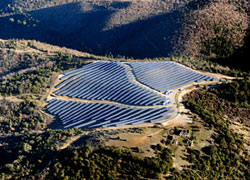In an example of how big renewable energy projects are shifting to developing countries, several big announcements have been made for Latin America and Africa.
A 30 MW solar PV plant under construction in Baja, Mexico, will be the biggest in Latin America to date, serving an estimated 160,000 households.
Portugal-based Martifer Solar is building the project, the first to have a long term Power Purchase Agreement with Mexico’s state-run utility, Comisión Federal de Electricidad. 132,000 solar trackers covering 100-acres come online this summer.
This project will open the way for the photovoltaic sector in the country, where, to date, only 13 MW has been installed, says Hector Olea, CEO of Gauss Energía, a local energy developer that’s behind the project.

Mexico’s solar potential is enormous. 70% of the country has an insolation of greater than 4.5 kWh/m²/day, which means that 16 square miles of solar – .01% of the land – could supply all of its electricity, explains Solar Love.
Mexico’s goal is to get 35% of its energy from renewable sources by 2024 under its national climate change plan.
Meanwhile, in Chile, there are much bigger plans afoot – Mainstream Renewable Power and Actis, a private equity firm, plan to build $1.4 billion of wind and solar projects – adding 600 megawatts (MW) of capacity by 2016.
Chinese developer Sky Solar is getting an infusion of $900 million from China Development Bank to build up to 300 MW of solar PV and First Solar acquired Solar Chile, which has 1.5 GW in varying stages of development.
And in South Africa, US-based SolarReserve is part of a consortium developing the 96 MW solar PV Jasper Solar Energy Project, one of the biggest in the continent. It is Google‘s first renewable energy investment in Africa.
The project was selected in the second round of bids under South Africa’s Renewable Energy Independent Power Producer Procurement Program (REIPPPP).
"The Jasper Power Project and other projects being developed through the REIPPPP have the potential to transform the South African power grid, and we’re proud to be a part of that effort," says Rick Needham, Google’s Director of Energy and Sustainability.
Because of this program, South Africa is showing the most rapid clean energy growth in the world. SolarReserve is also building two 75 MW solar PV projects there, the Letsatsi and Lesedi Projects, which come online in mid-2014.
The consortium behind these projects now hold a 20% share in South Africa’s solar market.
In Russia, the Ministry of Energy has approved the installation of 1.2 gigawatts (GW) of solar PV by 2020, as part of its goal to have 6 GW of renewable energy deployed by that date. That would translate into 2.5% of its electricity coming from renewables, up from 0.8% currently.
Contracts will be distributed via competitive bidding with a cap of $2.64 billion, and they will be prioritized based on how much of the equipment is produced domestically.
The opposite situation is occurring in Italy, which has been the second biggest solar market after Germany in recent years. It is ending its feed-in tariff program for new installations on July 6 because the program has reached the budget cap. The country is paying $8.9 billion for existing and approved projects.
Italy’s feed-in law has driven the installation of 17 GW since 2005, trailing only Germany, which has 32 GW.
Spain and Portugal did the same last year and Germany could follow after its September elections.
Since 2006, the world has invested $1.6 trillion in renewable energy and 2012 and employs 5.7 million people, according to a United Nations report. Solar installations reached a record 30.5 GW installed last year and wind energy rose to 48.4 GW.
For the first time, developing countries came close to advanced nations on investments in renewable energy last year. While five years ago, industrialized nations spent 2.5 times more, last year those countries invested $132 billion, close to the $112 billion invested by emerging economies.
138 countries now have renewable energy targets and two thirds of them are emerging economies, says the report.
"It is encouraging that renewable energy investment has exceeded $200 billion for the third successive year, that emerging economies are playing a larger and larger part, and that the cost-competitiveness of solar and wind power is improving all the time," notes Michael Liebreich, CEO of Bloomberg New Energy Finance, which contributed to the report. "What remains daunting is that the world has hardly scratched the surface – CO2 emissions are still on a firm upward trend and there was still nearly $150 billion of net investment in new fossil-fuel generating assets in 2012."
Still, 2011 was the first year that investments in renewable energy plants ($187 billion) exceeded that of fossil fuels ($157 billion).
Here is UNEP’s report, Global Trends in Renewable Energy Investment 2013:
